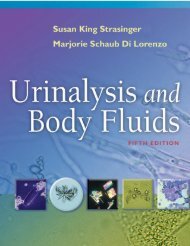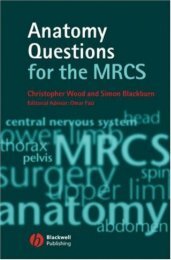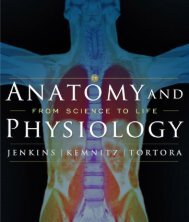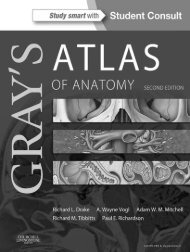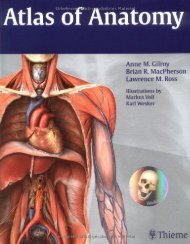theanatomyandphysiologylearningsystem4epdfdr-150930024720-lva1-app6891
Create successful ePaper yourself
Turn your PDF publications into a flip-book with our unique Google optimized e-Paper software.
Chapter 2 Chemistry, Matter, and Life 43<br />
Abbreviation<br />
oz<br />
Rx<br />
stat<br />
T.O.<br />
VS<br />
WA<br />
Clinical Terms<br />
Meaning<br />
ounce<br />
prescription, treatment, therapy<br />
immediately<br />
telephone order<br />
vital signs<br />
while awake<br />
Endemic (en-DEM-ick) Presence of a disease within a given<br />
population at all times<br />
Epidemic (ep-ih-DEM-ick) Sudden and widespread outbreak<br />
of a disease within a given population<br />
Etiology (ee-tee-AHL-oh-jee) Study of the causes of disease<br />
Functional disorder (FUNK-shun-al dis-OR-der) Disorder<br />
in which there are no detectable physical changes to explain<br />
the symptoms<br />
Iatrogenic illness (eye-at-roh-JEN-ick IHL-nehs)<br />
Unintended adverse condition in a patient resulting from<br />
medical treatment<br />
Idiopathic disorder (id-ee-oh-PATH-ick dis-OR-der) Illness<br />
that occurs without any known cause<br />
Infectious disease (in-FECK-shus dih-ZEEZ) Illness caused<br />
by a pathogenic organism<br />
Nosocomial infection (nos-oh-KOH-mee-ahl in-FECKshun)<br />
Infection acquired from the place of treatment<br />
Organic disorder (or-GAN-ick dis-OR-der) Disease<br />
accompanied by pathologic physical changes that explain<br />
the symptoms<br />
Pandemic (pan-DEM-ick) Occurring over a large geographic<br />
area; a widespread epidemic<br />
Use word parts given in this chapter to form words that have the following definitions.<br />
1. Many sugars<br />
2. Produce fat<br />
3. Molecule with two phosphates<br />
4. Taking energy away from<br />
5. Pertaining to two oxygens<br />
Match each of the following definitions with the correct word.<br />
VOCABULARY QUIZ<br />
_____ 6. Forming glycogen<br />
_____ 7. Less oxygen than ribose<br />
_____ 8. Basic, pH greater than 7.0<br />
_____ 9. Pertaining to carbon and water<br />
A. Alkaline<br />
B. Carbohydrate<br />
C. Deoxyribose<br />
D. Glycogenesis<br />
E. Lipolysis<br />
_____ 10. Breaking down fat<br />
Answer the following questions.<br />
11. What clinical term is used to denote the presence of a disease within a given population at all times?<br />
12. What is the clinical term for an illness that occurs without any known cause?<br />
13. What is the work of an etiologist?<br />
14. What is the meaning of the abbreviation T.O.?<br />
15. What is the meaning of the abbreviation DNR?




